Abstract
Baby-led approaches to complementary feeding promote intake of family foods rather than infant specific foods, from the start of the complementary feeding period, which advocates suggest should be less expensive. However, this has never been formally examined. We recently completed a 2-year randomised controlled trial comparing baby-led (BLISS) and traditional spoon-feeding (Control) approaches to complementary feeding in 206 infants. Perceived expense was assessed at infant 7, 8, 9 and 12 months of age. The actual cost of intake (food offered, consumed and left over) was calculated from 3-day weighed diet records at 7 and 12 months of age. BLISS was perceived as less expensive than traditional feeding (P = 0.002), but comparisons of actual costs showed only small differences in total daily cost for food offered (NZ$0.20 and NZ$0.10 at 7 and 12 months, respectively), consumed (NZ$0.30, NZ$0.20) or left over (NZ$0.10, NZ$0.20). Baby-led approaches are not cheaper for families than traditional spoon-feeding.
This is a preview of subscription content, access via your institution
Access options
Subscribe to this journal
Receive 12 print issues and online access
$259.00 per year
only $21.58 per issue
Buy this article
- Purchase on Springer Link
- Instant access to full article PDF
Prices may be subject to local taxes which are calculated during checkout
Similar content being viewed by others
References
Ministry of Health. Food and nutrition guidelines for healthy eating for infants and toddlers (aged 0–2): a background paper - partially revised December 2012. Wellington, NZ: Ministry of Health; 2008.
United States Department of Agriculture. Infant feeding and nutrition. In: Complementary foods. Washington, D.C: USDA; 2009. p. 101–28.
Scientific Advisory Committee on Nutrition. Feeding in the first year of life. London, UK: Public Health England, Ministry of Health; 2018.
Rapley G, Murkett T. Baby-led weaning. London: Vermilion; 2008.
Brown A, Lee M. An exploration of experiences of mothers following a baby-led weaning style: developmental readiness for complementary foods. Matern Child Nutr. 2013;9:233–43.
Cameron SL, Heath A-LM, Taylor RW. Healthcare professionals’ and mothers’ knowledge of, attitudes to, and experiences with, baby-led weaning: a content analysis study. BMJ Open. 2012;2:e001542.
Daniels L, Heath A-LM, Williams SM, Cameron SL, Fleming EA, Taylor BJ, et al. Baby-Led Introduction to SolidS (BLISS) study: a randomised controlled trial of a baby-led approach to complementary feeding. BMC Pediatrics. 2015;15:179.
Taylor RW, Williams SM, Fangupo LJ, Wheeler BJ, Taylor BJ, Daniels L, et al. Baby-led and conventional approaches to complementary feeding for obesity prevention: a randomised controlled trial. JAMA Pediatr. 2017;171:838–46.
Erickson EEW, Taylor RW, Haszard JJ, Fleming EA, Daniels L, Morison BJ, et al. Impact of a modified version of Baby-Led Weaning on infant food and nutrient intakes: the BLISS randomized controlled trial. Nutrients. 2018;10:740.
Bowman SA, Martin CL, Carlson JL, Clemens JC, Lin B-H, Moshfegh AJ. Food intakes converted to retail commodities databases 2003-08: Methodology and user guide. Beltsville, MD: U.S. Department of Agriculture, Agricultural Research Service; 2013.
Acknowledgements
We are grateful to all the families who participated in the BLISS study, and to the BLISS research staff in the Departments of Medicine and Human Nutrition at the University of Otago.
Funding
The BLISS Study was funded by Lottery Health Research, Meat & Livestock Australia, Karitane Products Society, Perpetual Trustees, The New Zealand Federation of Women’s Institutes, and the University of Otago, with ‘in kind’ contributions from Heinz Watties Ltd. RWT is supported by a Fellowship from Karitane Products Society. LD was in receipt of a University of Otago Doctoral Scholarship, and LWE was in receipt of a University of Otago Masters Scholarship. The funding sources had no role in the design and conduct of the study; collection, management, analysis or interpretation of the data; preparation, review or approval of the paper; or the decision to submit the paper for publication.
Author information
Authors and Affiliations
Contributions
RWT had full access to all the data in the study and takes responsibility for the integrity of the data and the accuracy of the data analysis. ALMH and RWT are co-Principal Investigators of the BLISS study, obtained the funding, and developed the study concept and design. All authors were involved in the acquisition, analysis or interpretation of data, and JJH designed and undertook all statistical analyses. EAF provided expert dietetic input. RWT wrote the first and subsequent drafts of the paper. All authors critically revised the paper for important intellectual content.
Corresponding author
Ethics declarations
Conflict of interest
The authors declare that they have no conflict of interest.
Additional information
Publisher’s note Springer Nature remains neutral with regard to jurisdictional claims in published maps and institutional affiliations.
Rights and permissions
About this article
Cite this article
Bacchus, S., Taylor, R.W., Fleming, E.A. et al. The cost of baby-led vs. parent-led approaches to introducing complementary foods in New Zealand. Eur J Clin Nutr 74, 1474–1477 (2020). https://doi.org/10.1038/s41430-020-0606-7
Received:
Revised:
Accepted:
Published:
Issue Date:
DOI: https://doi.org/10.1038/s41430-020-0606-7



